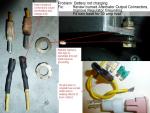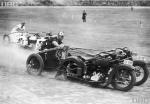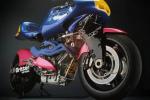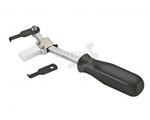-
Posts
1,010 -
Joined
-
Last visited
-
Days Won
43
Content Type
Profiles
Forums
Events
Gallery
Community Map
Everything posted by MartyNZ
-
I know how you feel. A fire under the tank would be bad. Roasted nuts? I would make sure that the wiring connections are tight so no sparks could cause a problem, then keep a close eye on the pump to make sure that the leaks really have stopped. I haven't pulled a pump apart to check, but I expect the seals are directional and internal fuel pressure will improve sealing. I believe that if it doesn't leak now, it will stay fuel tight for the rest of the summer. If it leaks again the following spring after another period being dry and idle, the chances of recovering again are lower. As for that engine noise, could valve clearance on a cylinder be set off TDC?
-
It could be a problem with your relay bases. The terminals that connect to the relays can be pushed back, or get loose. Then road vibrations can make a connection between a relay and the terminals in the base fail intermittently. KiwiRoy wrote a helpful guide on how to fix this problem here: http://www.v11lemans.com/forums/index.php?showtopic=15718
-
The photo was pretty dark which made it more difficult. And that red is a tough color to match on a good day. But this should be close: Good job with photoshop there Swooshdave. My bike has a darker green tank than the Greenies, and it has faded a lot. I can see a darker area that is normally covered by the seat. This made me think about a colour change. I like the blue and white you put on the bike, but not so keen on the header colour. I may leave the guards grey/black. The headers; I may just polish them if there isn't a ceramic coating available that is a pale whitish blue. But that blue looks great. Thanks for your efforts. Marty
-
Hey Swooshdave, what would my V11 Sport Naked look like with these colours? Blue and white, with red guards, and indigo ceramic on the headers, like some of the V1000 Brittens. http://www.motorcyclenews.com/news/first-rides-tests/2013/january/jan2313-mcn-rides-the-britten-v1000/
-
I was thinking about applying for associate membership as a wannabe with a black frame. But then I realised that I wouldn't want to belong to any club that would have me as a member. (quote: Groucho Marx)
-
My bike pipes from the headers to the crossover measure 45-47 mm, and the outlet from the crossover steps up to 51-51.5 mm where the mufflers slip on. Nice bike BTW.
-
After GuzziDiag is running, and connected to your bike, you can select >View > Faults. Then you will see two panels: current faults, and stored faults. There is a 'read' button at the bottom, and you get faults listed in those panels after you press this button.These is also a 'clear' button. When you clear stored faults, the ECU fault memory is erased, and GuzziDiag gets disconnected. If you reconnect GuzziDiag, you will see the stored faults are gone, unless there is some actual faults for it to store again. You can easily trigger a stored fault when you are setting the TPS by removing the TPS piggyback cable while the ignition is on. Then it stores a "TPS" fault.
-
I've seen fuel leaks caused by seals shrinking after the fuel dries out in storage. Most times, the leak stops 24 hours after the seals are re-wetted with fuel, and swell back to normal size again. Have you checked the pump again? If you want to store a used pump, you could keep the seals wet with diesel or 2 stroke oil.
-
Tomek, there could more than one fault which causes the charging voltage to be low. 1. AC voltage from alternator low, as Chuck says. See attached page from the workshop manual for AC voltage table at three different engine speeds. 2. Burned connectors in the yellow wires from alternator to regulator. See attached picture. 3. Poor grounding / earthing at the regulator, the timing case, battery connection, or the rear of the gearbox. 4. Melted 30 amp fuse. Moving wires to a better fuse holder fixes this. See attached picture. WMV11_Alternator&Reg.pdf
-
See Meinolf's offer here http://www.v11lemans.com/forums/index.php?showtopic=19652&do=findComment&comment=214733 He has maps that can do what you want, which are in use by many people on this forum. He has improved my bike a LOT. And Dangerous's. His maps are easy to install, and work flawlessly. He refused to take any payment from me, but suggested that I donate to the GuzziDiag developer, so I did. As always, Docc is right.
-
On a V11, you cannot set the PF3C TPS from a computer. GuzziDiag will only show you the ECU's interpretation of the TPS voltage. If the physical position of that TPS is wrong, then the ECU will have bad data. Then the ECU outputs for fuel and ignition will be sub-optimal. The TPS is set mechanically by loosening the clamp screws and twisting the TPS to the datum position. See guru Docc's instructions on how to do this here: http://www.v11lemans.com/forums/index.php?showtopic=19610.
-
So both Apple and Microsoft are a problem? Some days I think the same. Computers are one of the few consumer products that we expect to have trouble with. Good news. Now your bike is back to the ECU configuration it was delivered with in 2004. It's ok, but it can be awesome with a better .BIN map. Rather than loading the Ti map, (though it would be interesting to hear your views on it), you could ask Meinolf for something more developed.BTW, that Rosso Mandello map was copied from Cash1000's bike, so credit goes to him. However I forgot to ask him if it was ok to share. So yeah, Nigel, sorry, I hope you don't mind.
-
Here is a link to the parts you need to replace the needle roller. http://www.v11lemans.com/forums/index.php?showtopic=19514&page=2&do=findComment&comment=216691
-
-
I've been thinking about this too. As I try various ECU programs, it is obvious that exhaust gas analysis is a good way to test changes to the hardware and software on the bike. I suspect that my butt dyno can't discern a 5% change in power, especially if there is a change in noise at the same time. These guys have some interesting products that I'd like to try: http://www.zeitronix.com/index.html. AFR monitoring & logging would be the essential complement to tweaking ECU programming with TunerPro. The wideband sensor needs an 18mm port on the header or crossover, the existing plug looks too small, so I believe that I'd need to weld new ports on the headers. I just need some disposable cash. Sadly the easter bunny let me down, and xmas is a long time away.
-
I had some connection problems with getting the right driver for the cable. A cheap Chinese OBD2 cable would only connect to a 15M using the driver from the same site I got GuzziDiag from, but it refused to connect to a 15RC. The cable I bought from www.lonelec.co.uk worked best using Lonelec's driver. Windows 10 didn’t get the cable working, but forcing Lonelec's driver made it work. Once I consistently got a reliable connection on GuzziDiag, I have never had an issue with IAW15XWRITER. Dangerous and I both have succeeded in browsing for, and loading a .BIN file using a windows 10 or XP computer, but I can't comment about a Mac. I saw GuzziDiag fail to connect to a 15RC ECU when GD was set to a V11 model which uses 15M. It just returns a message "switch off ignition" after about 10 seconds of no other response, with no error message. Your error message could be related to a driver or cable problem.
-

Oil pressure during cranking (first start jitters!)
MartyNZ replied to Craig's topic in Technical Topics
Motrhead has a lesson about loose filters: http://www.v11lemans.com/forums/index.php?showtopic=19189 -
Hello Meinolf, Can you help me with a description of how to use this EEPROM Reader/Writer, and .XDF? More than one Kiwi tried the program, and then reverted to GuzziDiag after flailing around hopelessly without achieving anything. Can you help us dummies on the other side of the planet? MartyNZ
-
Hello John, PM me with your email address, and I can send you two .BIN maps for a 15M ECU. One is standard, and the other is a Titanium map. These will only suit a 15M ECU, not a 15RC. It is possible that some of your trouble could be if a 15M ECU is fitted to your bike, and you are telling GuzziDiag to connect to a 15RC. The 15RC was the standard fit on some 2004 V11s, with a corresponding lambda sensor in the crossover. Can you read the label on your bike to confirm what you have? Dangerous recently fitted a 15M ECU to his 2004 Nero Corsa in place of a 15RC. GuzziDiag only worked properly when we set it to a V11 model that used a 15M. The plug in the ECU is the same, and everything works the same, except that the 15M cannot see or react to inputs from the lambda sensor. He did that so he could use some of the more refined maps developed by Meinolf. If you need a standard .BIN map copied from a 15RC, I could borrow Dangerous's unused 15RC, power it up, and email you the result.
-
Martin, If you have a 15M or 15RC ECU in your V11, then you need GuzziDiag. A 2001 most likely has a 15M. Currently the latest GuzziDiag version is V0.47. Select the version for your computer operating system. If you bought the Lonelec cable (I recommend their well made and reliable package) then you should download the driver from their website. Even though windows 10 should make the cable work, I've seen W10 fail to connect till you visit Lonelec's site. The cable comes with good instructions. The old Windows XP netbook I use works well, with a rock solid connection to the ECU, so you don't need a new or powerful computer. The cable and GuzziDiag will let you do diagnostic checks and troubleshooting on your V11. It will also let you adjust your CO (fuel) trim. Here is the tutorial from Docc: http://www.v11lemans.com/forums/index.php?showtopic=19641 Once you get to that point, you are ready to save a copy of your .BIN file onto your computer using IAW15XREADER. This allows you to revert to the original .BIN file if you don't like any other .BIN you loaded. If you have another .BIN to load, you need IAW15XWRITER. This lets you overwrite the .BIN on the ECU with another. If you have a 15M ECU, then you could ask Meinolf if he could offer you a suitable .BIN for your bike. I'm on my 3rd .BIN, and my bike has improved from a cantankerous bitch to an awesome machine. Docc's Decent Tuneup guide can take some of the credit, but Meinolf has transformed my ECU from a croaking frog to symphonic harmony. Marty
-
Are you sure it isn’t a NZ beer label stuck on the frame? I only know of one NZ built bike in recent years, made by John Britten. My 03 V11 has a sticker on the spine near the steering head that says - MOTO GUZZI S.p.A. USA N. ZELANDA. ZGUKRAKRX3M1... I think that means that it was made in Italy for USA & NZ markets.
-
Some experts posted their experience here: http://www.v11lemans.com/forums/index.php?showtopic=19660 http://www.v11lemans.com/forums/index.php?showtopic=19814 http://www.v11lemans.com/forums/index.php?showtopic=19792 There is likely to be more good tips you could find if you use the search function Jaap built at the top of the page.
-
Yes, you can easily replace a seal with the shaft in place. If you search for "seal removal tool" you will see there are lots of tools that can help you. I use one like this to remove seals while the shaft is still in place: It is unlikely that you will remove the seal without damage to the seal, so you should try to have a replacement in your hand before you wreck the old one. Be careful not to scratch the shaft or seal housing as you pry it out. Have you seen this posting? http://www.v11lemans.com/forums/index.php?showtopic=19778
-
You have to wonder why the big manufacturers of diesel vehicles don't use this product, since it claims to offer "efficiency, durability, satisfaction, and increased performance". Perhaps the big guys like Cummins forgot to consider the need to keep out snake oil & lemming squeezings that might get into the fuel? Like you, I am intrested in things that are beneficial, but I'm not sure that this is any better than the OEM water separator & filter systems that come standard on diesel vehicles.
-
The Jackal workshop manual is available for download here: http://www.thisoldtractor.com/moto_guzzi_tonti_workshop_manuals___shop_manuals___service_manuals.html and FAQ here: http://www.thisoldtractor.com/moto_guzzi_tonti.html The manual mentions removing an "open washer".







